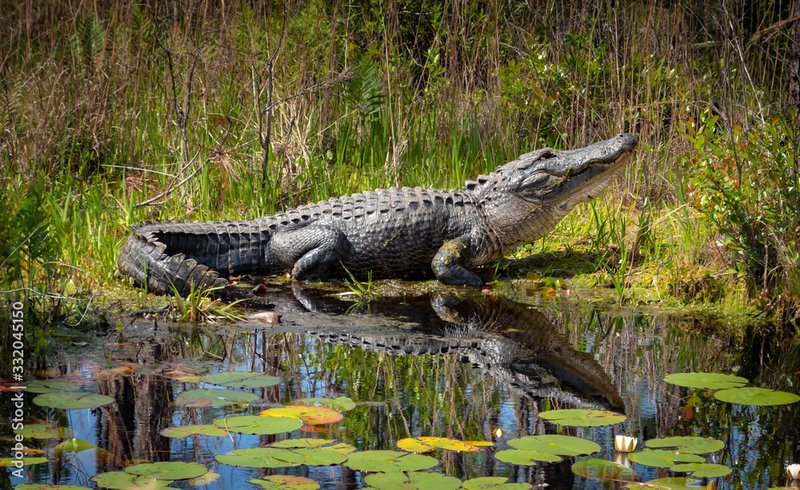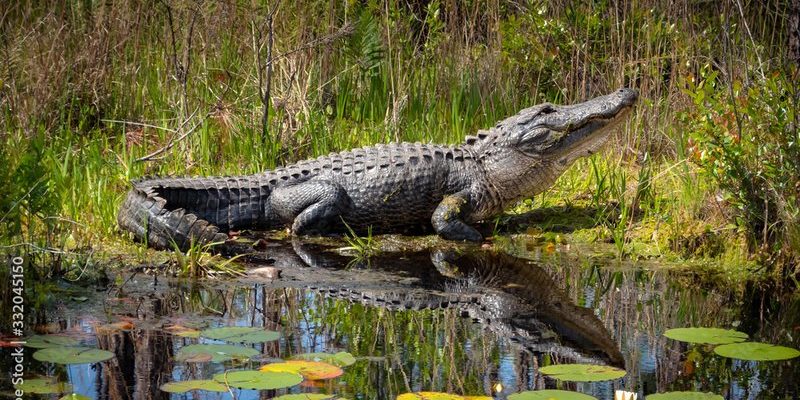
Imagine living in a world where the temperature swings from sweltering heat to icy chills. That’s life for the alligator, especially in places like Florida and the Carolinas. Their ability to endure these extremes is fascinating, and it all boils down to a mix of unique physical traits and clever survival strategies. Let’s dive into what makes these cold-blooded reptiles experts at adapting to harsh environments.
Physical Adaptations
One of the key reasons the American alligator can survive in challenging environments is its remarkable physical adaptations. Their bodies are built for a variety of settings, whether it’s a steamy swamp, a chilly pond, or even a drought-stricken river.
For starters, alligators have thick, scaly skin that not only protects them but also helps retain moisture. This is crucial in hot weather, where dehydration can be a real concern. Their skin is covered in bony plates called osteoderms, which provide an extra layer of defense against predators. You might think of these scales as nature’s version of body armor, allowing them to roam in dangerous waters without much worry.
Moreover, their powerful limbs and tails enable them to traverse various terrains easily. They can dig holes in mud to stay cool during hot days or find shelter during freezing nights. The tail also serves as a weapon and a tool for swimming efficiently. This versatility allows alligators to adapt to the changing conditions of their habitats.
Behavioral Strategies
It’s not just their bodies that help them survive; alligators also exhibit fascinating behaviors that allow them to thrive. For example, they are known to bask in the sun to regulate their body temperature. When it’s cold, you might see them lying on a rock or floating on the surface to soak up some warmth. This behavior is crucial because, as cold-blooded animals, they rely on external heat sources to function properly.
During the hotter months, alligators have the smart habit of submerging themselves in water. They create small depressions in mud, turning them into makeshift waterholes that help them cool down. Isn’t that clever? Even during a drought, these little ponds can sustain their energy levels, making it easier to survive until conditions improve.
Another behavioral aspect is their hunting strategy. Alligators are opportunistic feeders, meaning they take advantage of whatever food is available. They can go days or even weeks without eating and can consume 23% of their body weight in one meal. This is particularly helpful when food is scarce or when they’re in a habitat that doesn’t provide ample resources.
Breeding and Nesting Techniques
The survival of alligators isn’t just about them; it also extends to their young. The maternal instincts of female alligators are quite remarkable. They construct nests using mud and vegetation, which helps regulate the temperature for their eggs. In warm environments, the heat from decomposing plant material keeps the eggs warm, while the mud shields them from extreme heat.
Interestingly, the temperature of the nest also determines the sex of the hatchlings. Warmer nests tend to produce males, while cooler ones yield females. This unique adaptation allows alligators to balance their population based on environmental conditions. If the climate is heating up, more males are born to help ensure mating opportunities in the future!
After laying the eggs, the mother aggressively guards her nest. She’s willing to confront notable threats, ensuring a higher survival rate for her young. This protective behavior showcases how alligators have strategies in place to nurture the next generation, ensuring their species continues to thrive even in harsh settings.
Home Range and Territorial Behavior
When it comes to survival, territory is crucial for alligators. They have specific home ranges in which they feel secure and can find food and mates. These home ranges can be quite large, depending on the availability of resources. Alligators are known to be territorial, especially during the breeding season. Males will establish their space and defend it against invaders, which helps maintain their access to food and mates.
They also engage in vocalizations and body displays as a way to communicate and assert dominance. You might have heard their deep growls or bellows echoing across the waters—this is all part of their territory defense strategy. Such behaviors discourage potential competitors, ensuring that they can thrive in their chosen environment without too much conflict.
Moreover, the ability to adapt their territory based on changing environmental conditions is vital. For example, during extreme droughts, they might need to migrate to different areas where water is more plentiful, showcasing their flexibility in the face of change.
Resilience to Weather Changes
The American alligator exhibits impressive resilience to weather changes, which is vital for survival. They are surprisingly capable of sensing shifts in atmospheric pressure, preparing them for incoming storms. This instinct allows them to seek shelter and keep safe from severe weather.
During harsh winters, alligators go into a state of dormancy. They will often remain submerged in water with just their nostrils poking out. It’s like a natural hibernation that keeps them safe from freezing temperatures. When the warmer months return, they come back to life, ready to hunt and bask once again.
In addition, alligators have the ability to store fat in their bodies, which serves as an energy reserve during challenging times, like periods of food scarcity or drastic weather changes. This energy storage is a true lifesaver, allowing them to survive when conditions are less than ideal.
Impact of Human Activity
Unfortunately, the survival of the American alligator is also impacted by human activity. Habitat loss due to development, pollution, and climate change poses significant threats to their populations. Wetlands, which serve as crucial habitats for these creatures, are steadily disappearing.
However, conservation efforts are making a difference. Strategies like creating protected areas and regulated hunting have helped stabilize alligator populations in many regions. Understanding their role in the ecosystem is essential. Alligators help maintain the balance of their environments by regulating prey populations and creating habitats for other species when they dig dens or nest in the mud.
By respecting their habitats and learning more about their importance, we can contribute to ensuring these fascinating reptiles continue to thrive in even the harshest environments.
So, what can we learn from the American alligator’s ability to survive in harsh environments? It’s all about a combination of physical traits, clever behaviors, and adaptability. These creatures show us that survival isn’t merely about brute strength; it’s about being versatile and responsive to change.
As we continue to face our own environmental challenges, perhaps there’s inspiration to be found in the resilience of these magnificent reptiles. They’ve thrived for millions of years, proving that with the right adaptations and strategies, we can weather the storms—both literally and figuratively.

